Catalytic Oxidative Coupling of Phenols and Related Compounds
- PMID: 35928569
- PMCID: PMC9345132
- DOI: 10.1021/acscatal.2c00318
Catalytic Oxidative Coupling of Phenols and Related Compounds
Abstract
Phenols and their derivatives are the elementary building blocks for several classes of complex molecules that play essential roles in biological systems. Nature has devised methods to selectively couple phenolic compounds, and many efforts have been undertaken by chemists to mimic such coupling processes. A range of mechanisms can be involved and with well-studied catalysts, reaction outcomes in phenol-phenol oxidative coupling reactions can be predicted with a good level of fidelity. However, reactions with catalysts that have not been studied or that do not behave similarly to known catalysts can be hard to predict and control. This Perspective provides an overview of catalytic methods for the oxidative coupling of phenols, focusing on the last 10 years, and summarizes current challenges.
Keywords: biphenols; cross-coupling; dehydrogenative coupling; oxidative coupling; phenol coupling.
Conflict of interest statement
The authors declare no competing financial interest.
Figures

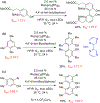






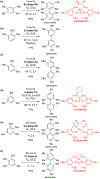




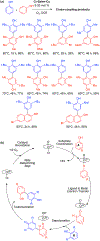

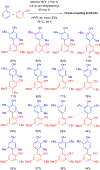
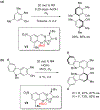



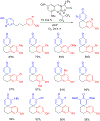







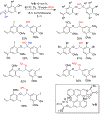
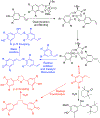


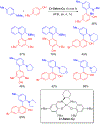
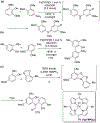






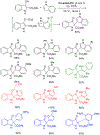
Similar articles
-
Metal- and reagent-free highly selective anodic cross-coupling reaction of phenols.Angew Chem Int Ed Engl. 2014 May 12;53(20):5210-3. doi: 10.1002/anie.201400627. Epub 2014 Mar 18. Angew Chem Int Ed Engl. 2014. PMID: 24644088
-
Oxidative Cross-Coupling of Two Different Phenols: An Efficient Route to Unsymmetrical Biphenols.Org Lett. 2015 Jun 19;17(12):3042-5. doi: 10.1021/acs.orglett.5b01324. Epub 2015 May 29. Org Lett. 2015. PMID: 26023816
-
Selective Synthesis of Partially Protected Nonsymmetric Biphenols by Reagent- and Metal-Free Anodic Cross-Coupling Reaction.Angew Chem Int Ed Engl. 2016 Sep 19;55(39):11801-5. doi: 10.1002/anie.201604321. Epub 2016 Jul 12. Angew Chem Int Ed Engl. 2016. PMID: 27401116
-
Catalytic dehydrogenative aromatization of cyclohexanones and cyclohexenones.Org Biomol Chem. 2018 Nov 21;16(45):8662-8676. doi: 10.1039/c8ob02351d. Org Biomol Chem. 2018. PMID: 30379180 Review.
-
Copper Catalyzed C-H Activation.Chem Rec. 2019 Jul;19(7):1302-1318. doi: 10.1002/tcr.201800107. Epub 2018 Oct 30. Chem Rec. 2019. PMID: 30375153 Review.
Cited by
-
Biocatalytic Enantioselective Synthesis of Atropisomers.Acc Chem Res. 2022 Dec 6;55(23):3362-3375. doi: 10.1021/acs.accounts.2c00572. Epub 2022 Nov 7. Acc Chem Res. 2022. PMID: 36343339 Free PMC article.
-
Recent advances in oxidative phenol coupling for the total synthesis of natural products.Nat Prod Rep. 2024 Feb 21;41(2):208-227. doi: 10.1039/d3np00009e. Nat Prod Rep. 2024. PMID: 37294301 Free PMC article. Review.
-
Atroposelective catalysis.Nat Rev Chem. 2024 Jul;8(7):497-517. doi: 10.1038/s41570-024-00618-x. Epub 2024 Jun 18. Nat Rev Chem. 2024. PMID: 38890539 Review.
-
An Enantioselective Suzuki-Miyaura Coupling To Form Axially Chiral Biphenols.J Am Chem Soc. 2022 Aug 24;144(33):15026-15032. doi: 10.1021/jacs.2c06529. Epub 2022 Aug 15. J Am Chem Soc. 2022. PMID: 35969692 Free PMC article.
-
Total Synthesis of Aporphine Alkaloids via Photocatalytic Oxidative Phenol Coupling and Biological Evaluation at the Serotonin 5-HT2 and Adrenergic α1A Receptors.J Med Chem. 2025 Jul 24;68(14):14628-14644. doi: 10.1021/acs.jmedchem.5c00771. Epub 2025 Jul 7. J Med Chem. 2025. PMID: 40623044 Free PMC article.
References
-
- Wang X; Wang Y; Geng Y; Li F; Zheng C Isolation and purification of honokiol and magnolol from cortex Magnoliae Officinalis by high-speed counter-current chromatography. J. Chroma 2004, 1036, 171–175. - PubMed
-
- Esumi T; Makado G; Zhai H; Shimizu Y; Mitsumoto Y; Fukuyama Y Efficient synthesis and structure–activity relationship of honokiol, a neurotrophic biphenyl-type neolignane. Bioorg, Med. Chem. Lett 2004, 14, 2621–2625. - PubMed
- Harada K; Arioka C; Miyakita A; Kubo M; Kufuyama Y Efficient synthesis of neurotrophic honokiol using Suzuki–Miyaura reactions. Tetrahedron Lett. 2014, 55, 6001–6003.
-
- Srinivas J; Singh PP; Varma YK; Hyder I; Kumar HS Concise total synthesis of honokiol via Kumada cross coupling. Tetrahedron Lett. 2014, 55, 4295–4297.
-
- Jaracz S, Kozlowski MC, Lee YE, and Kim SM (April 27, 2017) Improved synthesis of Honokiol, WO/2017/070568.
Grants and funding
LinkOut - more resources
Full Text Sources
